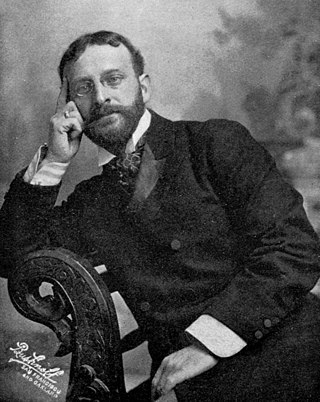
Divination is the attempt to gain insight into a question or situation by way of an occultic ritual or practice. Using various methods throughout history, diviners ascertain their interpretations of how a querent should proceed by reading signs, events, or omens, or through alleged contact or interaction with supernatural agencies such as spirits, gods, god-like-beings or the "will of the universe".

Infrared is electromagnetic radiation (EMR) in the spectral band between microwaves and visible light. It is invisible to the human eye. IR is generally understood to encompass wavelengths from around 750 nm to 1000 μm.

Dowsing is a type of divination employed in attempts to locate ground water, buried metals or ores, gemstones, oil, claimed radiations (radiesthesia), gravesites, malign "earth vibrations" and many other objects and materials without the use of a scientific apparatus. It is also known as divining, doodlebugging or water finding, or water witching.
A Hieronymus machine is any of the patented radionics devices invented by electrical engineer Thomas Galen Hieronymus. Hieronymus received a U.S. Patent for his invention in 1949, which was described in the patent application title as a device for "detection of emanations from materials and measurement of the volumes thereof".
The measurement of ionizing radiation is sometimes expressed as being a rate of counts per unit time as registered by a radiation monitoring instrument, for which counts per minute (cpm) and counts per second (cps) are commonly used quantities.
Automatic behavior is the spontaneous production of purposeless verbal or motor behavior without conscious self-control or self-censorship. This condition can be observed in a variety of contexts, including schizophrenia, psychogenic fugue, Tourette syndrome, epilepsy, narcolepsy, or in response to a traumatic event.

Explosive detection is a non-destructive inspection process to determine whether a container contains explosive material. Explosive detection is commonly used at airports, ports and for border control.
Witchcraft in Latin America, known in Spanish as brujería, is a complex blend of indigenous, African, and European influences. Indigenous cultures had spiritual practices centered around nature and healing, while the arrival of Africans brought syncretic religions like Santería and Candomblé. European witchcraft beliefs merged with local traditions during colonization, contributing to the region's magical tapestry. Practices vary across countries, with accusations historically intertwined with social dynamics. A male practitioner is called a brujo, a female practitioner is a bruja.
George Walter de la Warr was born in Northern England, and in later life became a civil engineer in the pay of Oxfordshire County Council. In 1953 he resigned from this post to work within the discredited field of radionics, in which he was a pioneer. His devices were denounced by medical experts.
Karl Spiesberger was a German mystic, occultist, Germanic revivalist and Runosophist. He is most well known for his revivalism and usage of the Sidereal Pendulum for divination and dowsing and for his anti-racialist stance and revivalist usage of the Armanen Futharkh runic system after the second world war, removing its negative connotations. During his involvement with the Fraternitas Saturni Spiesberger was also known as Frater Eratus. Under this name he published several articles in the Blätter für angewandte okkulte Lebenskunst.
Georges Lakhovsky was a Russian-French engineer, author, and inventor.

Moritz Benedikt also spelt Moriz was a Hungarian-Austrian neurologist who was a native of Eisenstadt.

Radionics—also called electromagnetic therapy (EMT) and the Abrams Method—is a form of alternative medicine that claims that disease can be diagnosed and treated by applying electromagnetic radiation (EMR), such as radio waves, to the body from an electrically powered device. It is similar to magnet therapy, which also applies EMR to the body but uses a magnet that generates a static electromagnetic field.

Psychic archaeology is a loose collection of practices involving the application of paranormal phenomena to problems in archaeology. It is not considered part of mainstream archaeology, or taught in academic institutions. It is difficult to test scientifically, since archaeological sites are relatively abundant, and all of its verified predictions could have been made via educated guesses.
Ernst Hartmann in Germany was a German medical doctor, author and publicist.

A pawang is a type of shaman from Indonesia and Malaysia. The pawang deals with magic involving weather, wild animals and spirits, but they may also be employed for cases of sorcery. Pawang are usually associated with mountains and sky in contrast to the traditional healers who are most often linked to rivers.

The ideomotor phenomenon is a psychological phenomenon wherein a subject makes motions unconsciously. Also called ideomotor response and abbreviated to IMR, it is a concept in hypnosis and psychological research. It is derived from the terms "ideo" and "motor". The phrase is most commonly used in reference to the process whereby a thought or mental image brings about a seemingly "reflexive" or automatic muscular reaction, often of minuscule degree, and potentially outside of the awareness of the subject. As in responses to pain, the body sometimes reacts reflexively with an ideomotor effect to ideas alone without the person consciously deciding to take action. The effects of automatic writing, dowsing, facilitated communication, applied kinesiology, and ouija boards have been attributed to the phenomenon.
Geobiology is a field which studies the effects of the Earth's radiation, such as telluric currents and other electromagnetic fields, on biological life. The term is derived from Ancient Greek gē (ge) meaning ‘earth’ and βίος; (bios) meaning ‘life’. Its findings have not been scientifically proven; thus, it is considered a subsection of pseudoscience.
Geopathology is a theory that links the Earth's inherent radiation with the health of humans, animals and plants.









